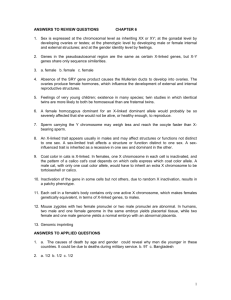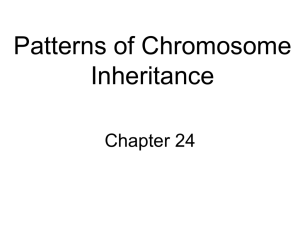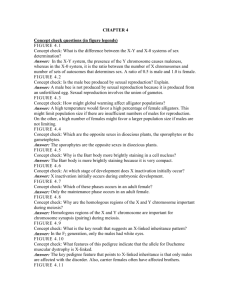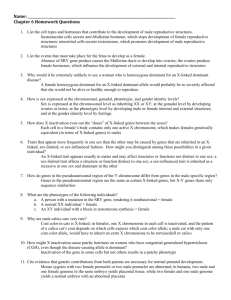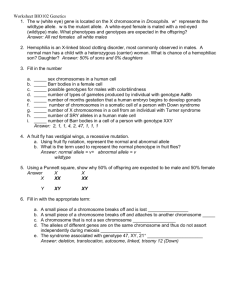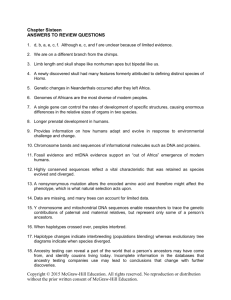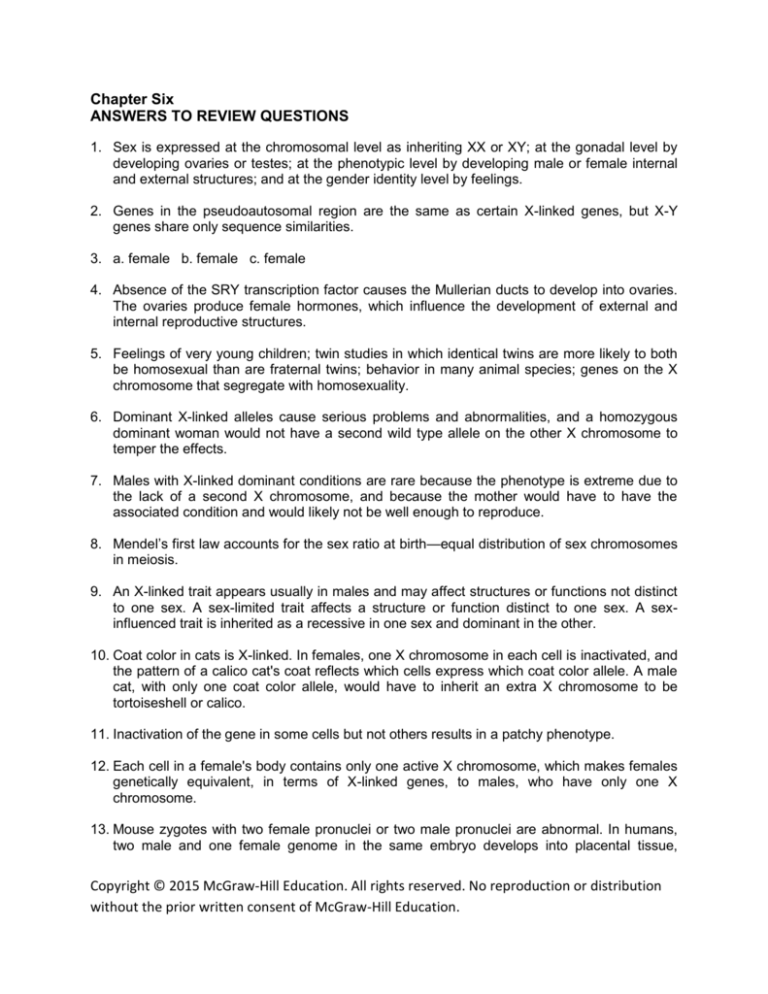
Chapter Six
ANSWERS TO REVIEW QUESTIONS
1. Sex is expressed at the chromosomal level as inheriting XX or XY; at the gonadal level by
developing ovaries or testes; at the phenotypic level by developing male or female internal
and external structures; and at the gender identity level by feelings.
2. Genes in the pseudoautosomal region are the same as certain X-linked genes, but X-Y
genes share only sequence similarities.
3. a. female b. female c. female
4. Absence of the SRY transcription factor causes the Mullerian ducts to develop into ovaries.
The ovaries produce female hormones, which influence the development of external and
internal reproductive structures.
5. Feelings of very young children; twin studies in which identical twins are more likely to both
be homosexual than are fraternal twins; behavior in many animal species; genes on the X
chromosome that segregate with homosexuality.
6. Dominant X-linked alleles cause serious problems and abnormalities, and a homozygous
dominant woman would not have a second wild type allele on the other X chromosome to
temper the effects.
7. Males with X-linked dominant conditions are rare because the phenotype is extreme due to
the lack of a second X chromosome, and because the mother would have to have the
associated condition and would likely not be well enough to reproduce.
8. Mendel’s first law accounts for the sex ratio at birth—equal distribution of sex chromosomes
in meiosis.
9. An X-linked trait appears usually in males and may affect structures or functions not distinct
to one sex. A sex-limited trait affects a structure or function distinct to one sex. A sexinfluenced trait is inherited as a recessive in one sex and dominant in the other.
10. Coat color in cats is X-linked. In females, one X chromosome in each cell is inactivated, and
the pattern of a calico cat's coat reflects which cells express which coat color allele. A male
cat, with only one coat color allele, would have to inherit an extra X chromosome to be
tortoiseshell or calico.
11. Inactivation of the gene in some cells but not others results in a patchy phenotype.
12. Each cell in a female's body contains only one active X chromosome, which makes females
genetically equivalent, in terms of X-linked genes, to males, who have only one X
chromosome.
13. Mouse zygotes with two female pronuclei or two male pronuclei are abnormal. In humans,
two male and one female genome in the same embryo develops into placental tissue,
Copyright © 2015 McGraw-Hill Education. All rights reserved. No reproduction or distribution
without the prior written consent of McGraw-Hill Education.
whereas two female and one male genome develops into a normal embryo with an
abnormal placenta.
14. Genomic imprinting
ANSWERS TO APPLIED QUESTIONS
1. a. The causes of death by age and gender b. 97 c. Bangladesh
2. a. 1/2 b. 1/2 c. 1/2
3. The unevenness of the teeth of affected females may reflect expression of the defect in only
some cells as the result of X inactivation.
4. Rett syndrome might be passed from mother to son if the mutant allele is silenced in her
brain cells, so that she has a mild phenotype and is well enough to reproduce.
5. The drug would allow expression of the gene from the paternal chromosome that might
compensate for the deletion in the maternal chromosome 15.
ANSWER TO WEB ACTIVITIES
1. An example is Rett syndrome, OMIM 312750, which causes autism, dementia, loss of hand
use, jerky movements, seizures, and poor growth.
2. Examples are 1) Cornelia de Lange syndrome, which causes growth retardation,
characteristic facial features, and intellectual disability. This comes from the mother. 2) WolfHirschhorn syndrome, with severe growth retardation, microcephaly, “Greek helmet face,”
heart defects, and cleft lip or palate. It comes from the father.
ANSWERS TO CASE STUDIES AND RESEARCH RESULTS
1. a. H
b. B, F
c. A
d. D e. E
f. B, F
g. D
h. H
i. D
2. 1/4
3. Pedigree.
Copyright © 2015 McGraw-Hill Education. All rights reserved. No reproduction or distribution
without the prior written consent of McGraw-Hill Education.
I
Edgar
Florence
II
Phil
Harold
Maude
Shirley
III
Marsha
Alvin
Simon
4. SRY
5. Maureen can see more nuances of color than most people.
Copyright © 2015 McGraw-Hill Education. All rights reserved. No reproduction or distribution
without the prior written consent of McGraw-Hill Education.

